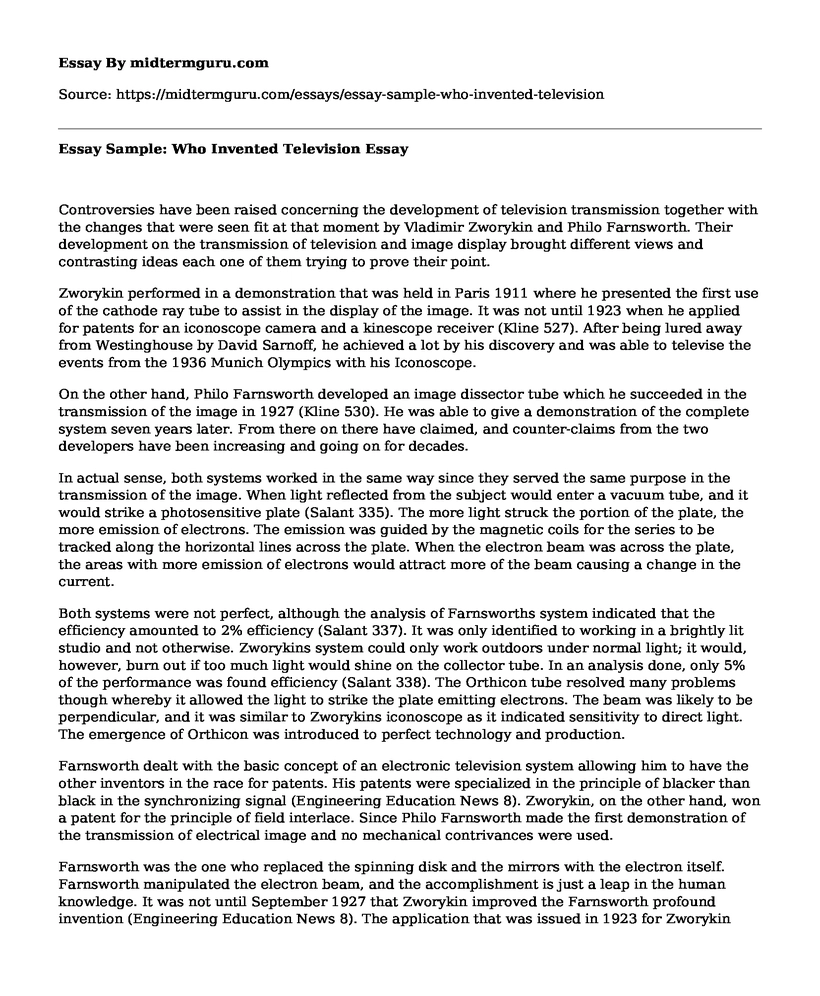Controversies have been raised concerning the development of television transmission together with the changes that were seen fit at that moment by Vladimir Zworykin and Philo Farnsworth. Their development on the transmission of television and image display brought different views and contrasting ideas each one of them trying to prove their point.
Zworykin performed in a demonstration that was held in Paris 1911 where he presented the first use of the cathode ray tube to assist in the display of the image. It was not until 1923 when he applied for patents for an iconoscope camera and a kinescope receiver (Kline 527). After being lured away from Westinghouse by David Sarnoff, he achieved a lot by his discovery and was able to televise the events from the 1936 Munich Olympics with his Iconoscope.
On the other hand, Philo Farnsworth developed an image dissector tube which he succeeded in the transmission of the image in 1927 (Kline 530). He was able to give a demonstration of the complete system seven years later. From there on there have claimed, and counter-claims from the two developers have been increasing and going on for decades.
In actual sense, both systems worked in the same way since they served the same purpose in the transmission of the image. When light reflected from the subject would enter a vacuum tube, and it would strike a photosensitive plate (Salant 335). The more light struck the portion of the plate, the more emission of electrons. The emission was guided by the magnetic coils for the series to be tracked along the horizontal lines across the plate. When the electron beam was across the plate, the areas with more emission of electrons would attract more of the beam causing a change in the current.
Both systems were not perfect, although the analysis of Farnsworths system indicated that the efficiency amounted to 2% efficiency (Salant 337). It was only identified to working in a brightly lit studio and not otherwise. Zworykins system could only work outdoors under normal light; it would, however, burn out if too much light would shine on the collector tube. In an analysis done, only 5% of the performance was found efficiency (Salant 338). The Orthicon tube resolved many problems though whereby it allowed the light to strike the plate emitting electrons. The beam was likely to be perpendicular, and it was similar to Zworykins iconoscope as it indicated sensitivity to direct light. The emergence of Orthicon was introduced to perfect technology and production.
Farnsworth dealt with the basic concept of an electronic television system allowing him to have the other inventors in the race for patents. His patents were specialized in the principle of blacker than black in the synchronizing signal (Engineering Education News 8). Zworykin, on the other hand, won a patent for the principle of field interlace. Since Philo Farnsworth made the first demonstration of the transmission of electrical image and no mechanical contrivances were used.
Farnsworth was the one who replaced the spinning disk and the mirrors with the electron itself. Farnsworth manipulated the electron beam, and the accomplishment is just a leap in the human knowledge. It was not until September 1927 that Zworykin improved the Farnsworth profound invention (Engineering Education News 8). The application that was issued in 1923 for Zworykin was for the Iconoscope, and the patent was granted. Zworykin had built some tubes and applied current to them, but the transmitter was known to cause more difficulties.
The controversies are the fact that there were application and claim for a patent in 1923, but only Farnsworth had a successful demonstration and not Zworykin. With him, there was no conclusive documentation. But with the Patent ruling obtained in 1938, it would be rude not to conclude that both Zworykin and Farnworth can be considered co-inventors.
Work cited
Engineering Education News. Engineering Education News, vol. 10, no. 5, 1983, pp. 88. www.jstor.org/stable/43886870.
Kline, Ronald. Isis. Isis, vol. 79, no. 3, 1988, pp. 523524., www.jstor.org/stable/234715.
Salant, Richard S. The Television Debates: A Revolution That Deserves a Future. The Public Opinion Quarterly, vol. 26, no. 3, 1962, pp. 335350., www.jstor.org/stable/2747223.
Cite this page
Essay Sample: Who Invented Television. (2021, Jun 03). Retrieved from https://midtermguru.com/essays/essay-sample-who-invented-television
If you are the original author of this essay and no longer wish to have it published on the midtermguru.com website, please click below to request its removal:
- Essay on the Future of Renewable Energy in Turkey
- Essay on Cell Phones and Their Impact on Health for Teenagers
- Essay Sample on Epic System in Medicine
- The Future of Energy - Essay Sample
- Digital Privacy: Securing Your Data in the Age of Mobile Devices - Essay Sample
- AI Revolution - Essay Sample
- Robot Reporters: Implication on Job Availability in Media - Essay Sample







